Snails are infamous for their capability to reproduce and multiply in favorable environments rapidly. While snail eggs are pretty resilient, a certain level of care is critical for them to survive and thrive.
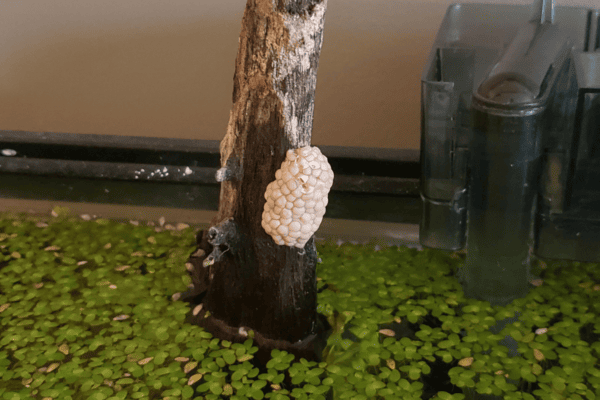
In this article, we’ll go through every detail about snail egg care and will try to help you identify, raise, and grow your snail colony. They can either become a healthy part of your aquarium or the source of live food for your fish.
Table of Contents
Snail Eggs: Overview
Snails are characterized by their soft body and external hard shell. Most aquarium snails, in addition to their beautiful textures, are efficient scavengers and algae cleaners. Snails belong to a class of animals called Gastropoda and are easily identifiable.
Snail eggs, on the other hand, are small and are pretty hard to distinguish. If you have a few species of snails in your aquarium, you may need to identify the eggs before starting to take care of them.
Appearance
Depending on the species and the status of their fertilization, the appearance of your snail eggs may vary. From the translucent eggs of Ramshorn Snails to vibrant pink eggs laid by Apple Snails, the care required for each one is different.
Throughout fertilization, the color of the snail eggs may deviate towards a darker shade due to the development of the embryo, but they often aren’t noticeable enough.
Typically, snails lay their eggs in a protective gelatinous sac in clusters above or below the water. However, the Assassin and Trumpet snails are known to scatter their eggs across the substrate and various aquarium surfaces.
Snail Eggs Location
To care is to find. Before you can take care of your snail eggs, you must actively seek them to isolate (if they have tank mates) or keep an eye on them. A few locations where snail eggs may be found are:
1. Above Waterline
Mystery Snails and Apple Snails are known to generally lay their eggs above the waterline, attaching them to aquarium glass, plants, and other surfaces. The eggs are kept moist by the snails or the environment.
2. Below Waterline
Some species of snails, like Pond Snails and Ramshorn Snails, lay their eggs below the waterline. Rocks, plants, and coarse decorations are the most preferred spots for these snail mommies.
3. Substrate Buried
A few snail species bury their eggs deep inside the substrate to protect them. Trumpet Snails are an example of such behavior.
4. Floating
Creating small floating clusters or rafts, Apple Snails lay their eggs floating in the water.
Types/Varieties of Snail Eggs
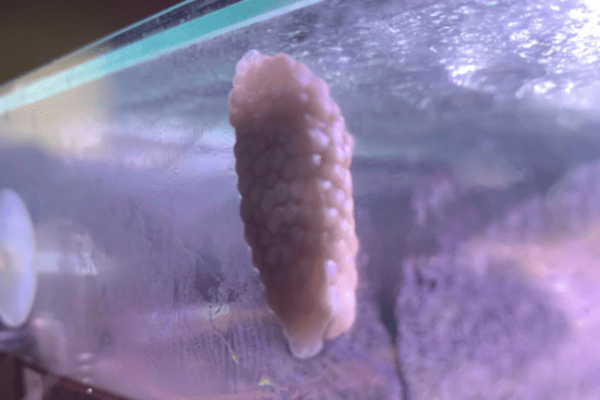
Most snail species lay eggs in clusters and usually aren’t too keen to hide them. If you already keep snails, you don’t need to worry about their lineage.
However, if you decide to give care to hitchhiked snail eggs in your aquarium, it’s better to know their characteristics and species beforehand.
1. Gelatinous Egg Clusters
This type of snail egg is usually round or oval-shaped and has a translucent or pinkish color. Species that lay gelatinous egg clusters are:
- Apple Snails
- Mystery Snails
- Golden Apple Snail
2. Capsule Eggs
Ranging from a few millimeters to a couple of centimeters. Capsule snail eggs are oval and enclosed in a tough shell. They’re usually found in submerged rocks and decorations. Species that lay capsule eggs are:
- Pond Snails
- Malaysian Trumpet Snail
- A few species of Spike-Topped Apple Snails
3. Ribbon-Like Egg Strings
Appearing like a long thin string, ribbon-like egg strings are usually found in substrates and attached to aquarium rocks. These are typically whitish or translucent in color. Species that lay such type of egg are:
- Nerite Snails
- Bithnia Snails
- Assassin Snails
Lifespan of Snail Eggs
Depending on the species, the incubation period of the snail eggs may vary. In most cases, from the time of laying, it takes around 2-4 weeks for the baby snails to hatch. Here is a brief chronology of the events.
- Egg Laying:
The female snail lays eggs on plants, rocks, and other aquarium decorations. The eggs are deposited over a few months period, usually during spring.
- Embryo Development:
The embryos start developing within the protective shells. Given a favorable environment, it should last between a few days to several weeks.
- Incubation Period:
The embryos continue to develop internally during this period. These changes aren’t visible yet.
- Visible Changes:
The shell, color, transparency, and size of the eggs alter during this period to signify visible changes in the embryo.
- Hatching
Once the development is complete, the eggs hatch and juvenile snails emerge. Depending on the species, the outer shells may take a few more days to harden and grow.
Snail Eggs Size
Here are a few snail egg sizes, depending on the species.
- Apple Snails: 2-3 mm (source)
- Mystery Snails / Spiked-top apple snail: 2.2-3.5mm (source)
- Ramshorn Snail: 1-3 mm
- Pond Snail: Less than 1 mm in diameter (source)
Snail Eggs: Care and Tank Setup
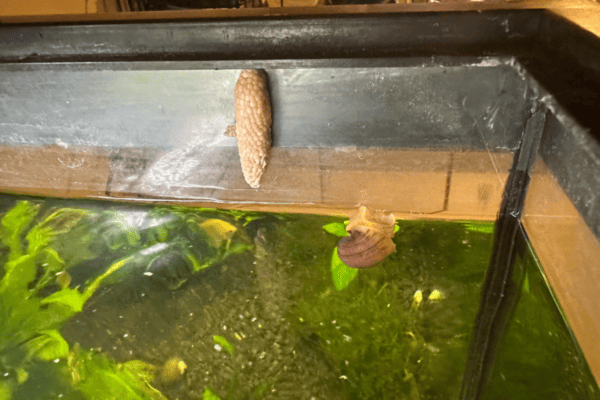
After identification, it’s time to give proper care to your snail eggs and help them survive beyond hatching. In this section, we’ll discuss the elements to help you out.
Tank Size and Specifications
As with any aquatic animal, snails and their eggs have tank space and other critical requirements.
1. Optimum Tank Size
Snail eggs don’t move around and don’t have a lot of space requirement. For small species, an average of 5 to 10-gallon tanks are optimum for building a snail hatchery. The rule of thumb is to provide ample space without losing the convenience of batch transport to another tank(s).
For larger species like Golden Apple Snail, you need to arrange for a bit larger tank to keep the hatchlings healthy and growing. However, you would need to eventually provide larger tanks or ponds to accommodate the growing colony.
Moreover, depending on the growth rate, adult sizes, and number of eggs, you may need a larger tank for some species.
2. Suitable Tank Shape
There isn’t any “suitable” tank shape for the snail eggs. But, you may choose a tank that allows substrates, monitoring, and filtration.
As some snail species lay their eggs inside substrates or on decorations and rocks, having those elements in your tank encourages breeding pairs to reproduce.
The tank shape should only matter in case there is an issue with visibility and filtration systems. Visually constrictive elements like bowls, deformed aquariums, and glass boxes may limit supervision.
3. Filter Type
Never employ a high input or output filter in your snail eggs tank. As they don’t usually poop a lot, the best filters for the job are:
- Sponge Filters:
Sponge filters offer gentle water flow and a low suction rate to act as mechanical and biological filters.
- Air-Driven Filters
Connected to the air pump, Air-driven filters also use sponges to biologically and mechanically filter the water.
- Pre-filter sponge
A piece of sponge may be introduced before the input of canister filters to prevent the eggs from being sucked inside.
- Output Baffles
To reduce the flow rate, DIY output baffles can be used.
4. Substrate
Sand is the best substrate for aquarium snail eggs. Irrespective of the species, they’re more comfortable navigating through the softer sand than gravel or pebbles.
Feeding, breeding, and laying eggs on or in the sand is also easier for snails. For example, the Trumpet Snail lays eggs under the substrate to safeguard their hatchlings. Using sand makes it easier for them to borrow.
As a hobbyist, working with sand is also easier. A thin layer of sand should allow you to monitor and care for the eggs better than other substrates.
Spawning mats also are great choices if you’ll be dedicating the tank to snail eggs. These mats mimic the appearance and texture of underwater plants and encourage underwater snails to lay eggs on them. However, substrate burying isn’t possible with this method.
How many snail eggs can hatch in a 5-gallon tank?
It’s hard to provide an exact number of snail eggs that you can hatch in a 5-gallon tank. Depending on the species, the number of eggs laid, and the survival rate, it can vary from a few hundred to thousands of snail eggs.
For adult small species like Ramshorn Snails or Pond Snail, you can keep 6-12 snails per gallon of water.
For adult bigger species like Mystery snails, target 6 snails per 5 gallons of water.
Even if your snail eggs hatch in hundreds, consider moving them to a bigger tank and avoid overcrowding by the removal of juvenile snails.
Water Parameter for Snail Eggs
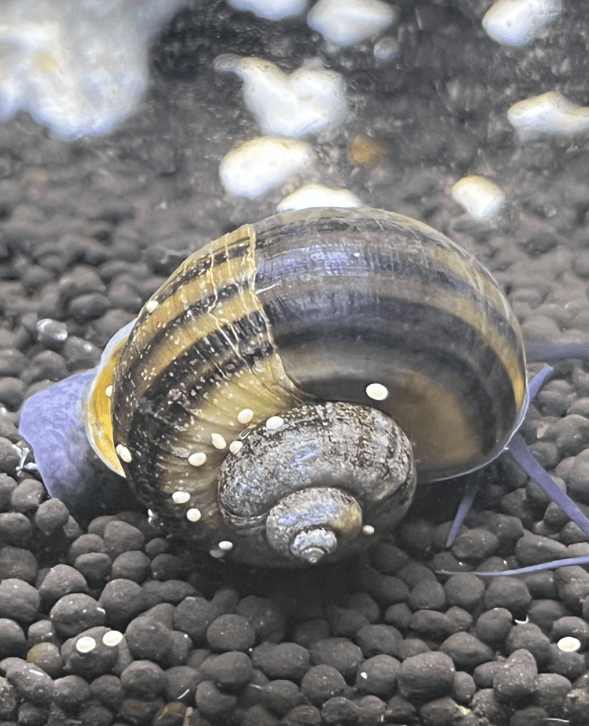
Basic water parameters that work for snail eggs are discussed.
Water Temperature
While the optimum temperature for different snail egg species may vary, most freshwater snails thrive in between 65-87 F temperatures.
Water Flow Rate
Snail eggs don’t require a vortex method or high water flow to hatch. Keep your filter to its lowest setting and maintain a slow flow rate throughout.
pH Level
A neutral and slightly basic water of pH 7-8 is optimum for keeping snail eggs. Make sure that the water doesn’t contain copper, salt, or any other lethal metals.
Water Hardness
For proper shell structure and strength, a 7-9 dGH (70-90 ppm of calcium) degree of hardness is optimum to keep snail eggs.
Tank Landscape
Tank landscapes play an essential role in raising snail eggs. As most mamma snails lay their eggs in crevices, decorations, rocks, and even filter bodies, it’s important to provide them with the best.
Best Plants for Snail Eggs Tanks
Plants with dense & bushy structures and delicate & broad leaves, are appropriate for snail eggs. A few examples of such plants may be:
- Java Moss
Well suited for small tanks, Java Moss is a strong and hardy plant that helps snails lay their eggs on its fine branching leaves.
- Hornwort
Feathery foliage for Hornwort plants helps snails lay their eggs in a larger surface area. Hornworts are low-maintenance and sturdy.
- Water Sprite
Water Sprite is great for snails that lay eggs above the waterline. These plants can be anchored or allowed to float freely above water.
- Anubis
With broad sturdy leaves, Anubis is a great choice for hobbyists with small tanks. Its broad, sturdy leaves allow snails to crown up and lay eggs on it.
Worst Plants for Snail Eggs Tanks
Any plants that have rough and sharp leaves, grow rapidly, or have excessive movement in water aren’t suitable for snail eggs. However, there are a few certain common aquarium plants that are toxic to snail eggs.
- Dieffenbachia (Dumb Cane)
It contains calcium oxalate crystals that can damage snail eggs if they come into contact.
- Philodendron
Also contains calcium oxalate and may damage snail eggs.
- Pothos
Contains calcium oxalate and causes snail eggs to die.
- Peace Lily
In addition to calcium oxalate crystals, it contains many other toxic compounds harmful to snail eggs.
Decorations for Snail Eggs Tanks
Snails are curious creatures. They tend to explore crevices and small openings in rocks and other decorations to lay their eggs. A few decorations that are suitable for snail eggs are:
- Smooth decorations: Decorations with sharp edges and rough surfaces may cause the snails to harm themselves and the eggs.
- Decorations with larger crevices.
- Non-toxic decoration:
Avoid decorations with toxic substances. For example, dyes, paints, and metallic ions shouldn’t be present.
Tanks Mates
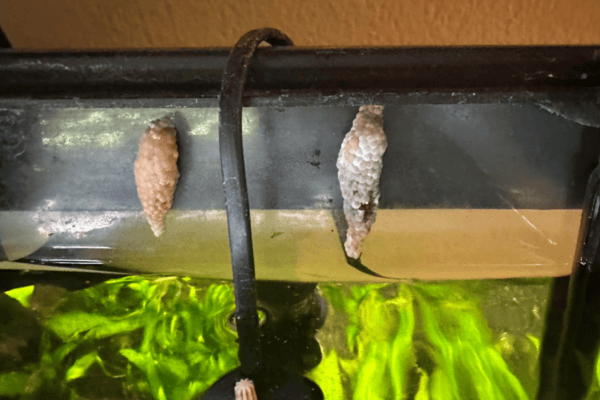
If you’ve decided not to dedicate a separate tank for snail eggs, you must consider good and bad tank mates for your snail eggs and juveniles.
Ideal Snail Egg Tank Mates
Ideal tank mates for snail eggs are peaceful, mostly bottom-dwelling, and other snail species. A few fish that are reasonable to keep with snail eggs are:
- Guppy
- Molly
- Neon Tetra
- Rasbora
- Cherry Shrimp
- Amano Shrimp
- Ghost Shrimp
- Nerite Snail
- Mystery Snail
Bad Tank Mates for Snail Eggs
Any fish that are aggressive toward other creatures are bad tank mates for snail eggs. Invertebrate predators like crawfish and larger shrimps aren’t suitable to be snail egg mates. Moreover, a few snail species also are bad for snail eggs.
A few bad tank mates may be:
- Cichlids
- Oscars
- Jack Dempseys
- Tiger Barbs
- Red-Tailed Sharks
- Archerfish
- Crayfish
- Larger predatory shrimp species (e.g., Macrobrachium spp.)
- Bettas
Common Snail Eggs Diseases and Their Treatment
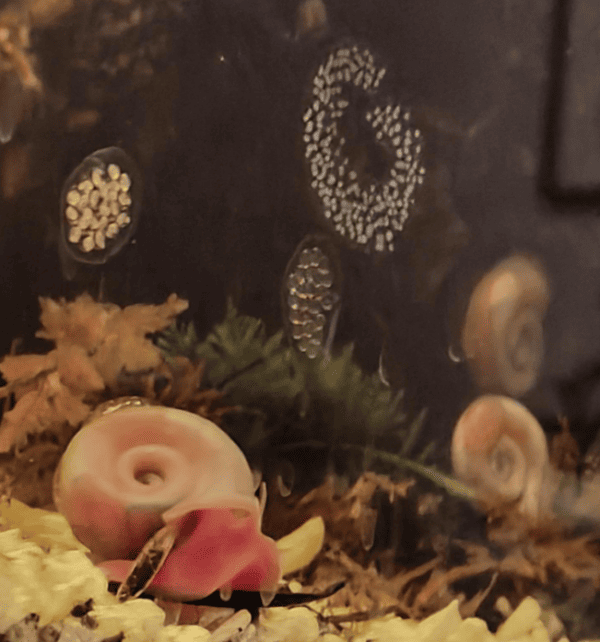
Snail eggs can stay dormant for months before embryos can start developing. However, diseases are pretty common in developing eggs and can eradicate the whole colony. Some of them are:
1. Fungal Infections
Snail eggs may be subjected to fungal pathogens, leading to fungal growth on the egg surfaces. Treatment typically involves removing infected eggs and improving water conditions through filtration.
Fungicides or antifungal treatments specifically formulated for aquatic environments may also be used.
2. Bacterial Infections
Bacterial infections can cause decay, discoloration, or foul odor in snail eggs.
Treatment involves maintaining clean water conditions, removing infected eggs, and improving water quality. Antibiotics or antibacterial treatments may be used in severe cases.
3. Parasitic Infestations
Parasites like nematodes or trematodes can infest snail eggs. Abnormal egg development and low hatchability are common symptoms.
Treatment options may include the use of specific medications or treatments designed to target the particular parasite.
Facts About Snail Eggs
- Snail eggs are usually small and range from about 1 to 6 millimeters in diameter.
- Snail eggs can be white, pink, transparent, or light yellow, depending on the species.
- Snails lay their eggs in clusters. A cluster may hold anything from tens to hundreds of snail eggs.
- Shells of the snails, apart from protecting them from predators, help them stay hydrated. Snail shells are made from calcium carbonate.
- Most snail eggs require a moist environment to develop properly.
- It takes several weeks for snails to hatch after breeding.
- Most snails are hermaphrodites, meaning they can self-fertilize (if needed). One single snail can reproduce and make hundreds of eggs.
- Snail eggs don’t get or require parental care after being laid.
- In outdoor settings, snail eggs are often targeted by birds, insects, and other small animals. In aquariums, tank mates can feed on them.
- A few species of snail eggs are used as a culinary delight.
- Snails have an organ called a “love dart” that they stab each other with to mate.
The Bottom Line
Hopefully, you’ll now be able to properly give care to your slimy friends and their hatchlings. Although we’ve tried informing you about common snail species that are different in characteristics from each other, there are hundreds of other snails that may not fit the care guide.
If you happen to keep exotic or imported snails, consider doing your own research before falling back on this article. Also, snails can be devastating to flora and fauna. Therefore, it’s advised to not release foreign snails in the wild.
